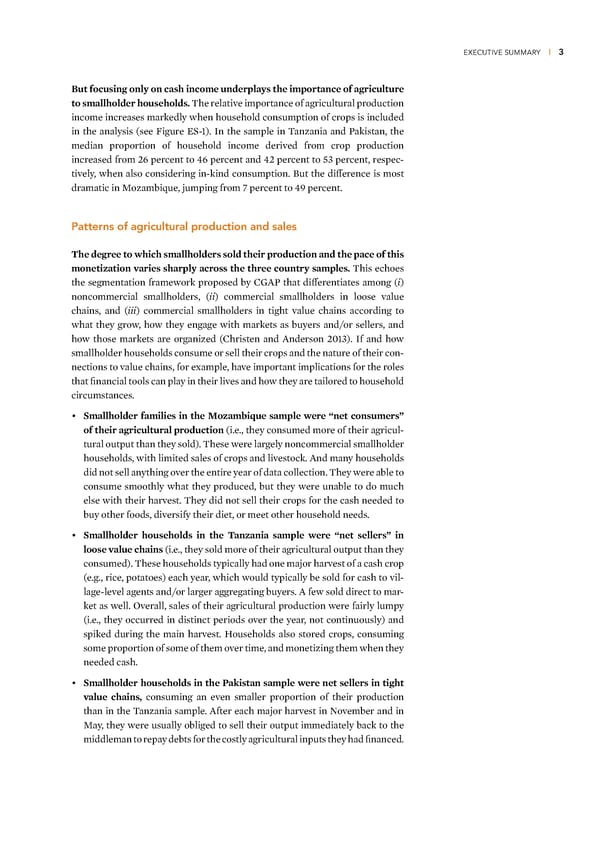EXECUTIVE SUMMARY | 3 ut focusing only on cash income underplays the importance of agriculture to smallholder households Œhe relative importance of agricultural production income increases maredly when household consumption of crops is included in the analysis (see igure œS-…) €n the sample in Œan—ania and aistan, the median proportion of household income derived from crop production increased from ‘¢ percent to “¢ percent and “‘ percent to ”Ÿ percent, respec- tively, when also considering in-ind consumption £ut the difference is most dramatic in –o—ambiue, „umping from • percent to “ž percent Patterns of agricultural production and sales he degree to which smallholders sold their production and the pace of this monetiation aries sharply across the three country samples Œhis echoes the segmentation framewor proposed by †‡ˆ that differentiates among (i) noncommercial smallholders, (ii) commercial smallholders in loose value chains, and (iii) commercial smallholders in tight value chains according to what they grow, how they engage with marets as buyers and¤or sellers, and how those marets are organi—ed (†hristen and ˆnderson ‘’…Ÿ) €f and how smallholder households consume or sell their crops and the nature of their con- nections to value chains, for example, have important implications for the roles that financial tools can play in their lives and how they are tailored to household circumstances • Smallholder families in the oambi ue sample were “net consumers” of their agricultural production (ie, they consumed more of their agricul- tural output than they sold) Œhese were largely noncommercial smallholder households, with limited sales of crops and livestoc ˆnd many households did not sell anything over the entire year of data collection Œhey were able to consume smoothly what they produced, but they were unable to do much else with their harvest Œhey did not sell their crops for the cash needed to buy other foods, diversify their diet, or meet other household needs • Smallholder households in the anania sample were “net sellers” in loose alue chains (ie, they sold more of their agricultural output than they consumed) Œhese households typically had one ma„or harvest of a cash crop (eg, rice, potatoes) each year, which would typically be sold for cash to vil- lage-level agents and¤or larger aggregating buyers ˆ few sold direct to mar- et as well ¦verall, sales of their agricultural production were fairly lumpy (ie, they occurred in distinct periods over the year, not continuously) and spied during the main harvest Households also stored crops, consuming some proportion of some of them over time, and moneti—ing them when they needed cash • Smallholder households in the ‚aƒistan sample were net sellers in tight alue chains, consuming an even smaller proportion of their production than in the Œan—ania sample ˆfter each ma„or harvest in ˜ovember and in –ay, they were usually obliged to sell their output immediately bac to the middleman to repay debts for the costly agricultural inputs they had financed
 Financial Diaries with Smallholder Families Page 12 Page 14
Financial Diaries with Smallholder Families Page 12 Page 14